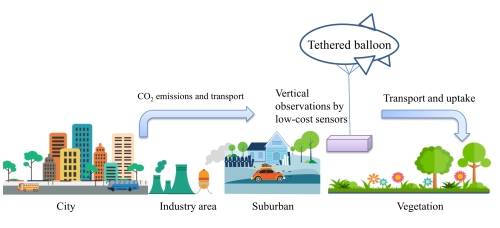The Best Things Come in Small Packages: Successful Application of a Miniaturized Instrument for Carbon Dioxide Vertical Observations
Date:2020-04-22
Carbon dioxide is the most important greenhouse gas in the atmosphere and its vertical concentration gradient is important for an accurate understanding and interpretation of global warming, the inversion of carbon sources and sinks, the calibration and validation of atmospheric transport models, and remote sensing measurements.
Conventional high-precision carbon dioxide measurement instruments, due to the large size, heavy mass of supporting systems and high price, are difficult to apply to vertical observation, so in situ measurement of carbon dioxide vertical profiles within the boundary layer is rare.
After years of effort, the Carbon Cycle and Climate Change Group from the Institute of Atmospheric Physics (IAP), Chinese Academy of Sciences, and Prof. Ning Zeng from the University of Maryland, USA, have successfully developed a low-cost miniaturized carbon dioxide monitoring instrument based on non-dispersive infrared technology. The small size and light weight of the instrument make it easy to be mounted on a sounding device for vertical observation of carbon dioxide concentrations.
During 8–14 January 2019, the research team loaded the instrument onto a vertical detection system of the tethered balloon from the Sub-Center of Atmospheric Sciences, Chinese Ecosystem Research Network, IAP and successfully conducted in situ observations of the carbon dioxide vertical distribution in the boundary layer (0–1000 m) in the southwestern part of Shijiazhuang City, Hebei Province, China. Dr. WANG Yinghong, a researcher from Prof. WANG Yuesi’s group, collected gas samples of different heights and measured them precisely with a gas chromatograph in the laboratory.
From data analysis, the miniaturized instrument produced very consistent carbon dioxide vertical profile results with those obtained by conventional gas chromatography analyzers. "After one week of continuous observations, we found that the carbon dioxide concentration basically tends to decrease with increasing altitude and that the vertical distribution of carbon dioxide concentration in the boundary layer is mainly influenced by the stability of the boundary layer and emission sources, and these results were further confirmed by atmospheric model simulations”, explains the corresponding author, Dr. HAN Pengfei from the IAP. All these results have recently been published in Atmospheric and Oceanic Science Letters.

Diagram of CO2 emissions and transport between city and suburban areas and vertical observations of CO2 using the low-cost sensor and tethered balloon.
The miniaturized instrument provides a simple and efficient method for vertical carbon dioxide observation, which is promising for applications and has high replication value. "We set up a high-density observation network in the Beijing, Tianjin, and Hebei regions by using the advantages of such a low-cost and high-precision instrument, and observed the temporal and spatial characteristics of urban carbon dioxide changes at the kilometer scale, which will provide scientific data for policymaking with respect to carbon emissions reduction and low carbon development in China", concludes HAN.
Citation:
Zhongxiu BAO, Pengfei HAN, Ning ZENG, Di LIU, Qixiang CAI, Yinghong WANG, Guiqian TANG, Ke ZHENG & Bo YAO (2020): Observation and modeling of vertical carbon dioxide distribution in a heavily polluted suburban environment, Atmospheric and Oceanic Science Letters 13(4), https://doi.org/10.1080/16742834.2020.1746627
Media contact: Ms. LIN Zheng, jennylin@mail.iap.ac.cn
